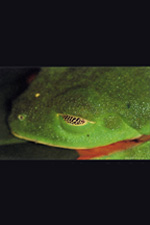|
||||
Nictating membrane http://jrscience.wcp.muohio. edu/tropics/costaricaimage collection.html |
Adaptions/Defense mechanisms of the red-eyed tree frog: • Nictating Membrane The red-eyed tree frog has a third eyelid called a nictating membrane. This membrane protects the frogs eyes from dangers it might encounter while still allowing the frog to partially see through the membrane. When a predator approaches a resting frog it will abruptly open its eyes revealing a bright red iris, against an otherwise green body. This can be used to startle the predator and give the tree frog a chance to escape. • Bright Colors During the day the red-eyed tree frog is asleep in what is called the diurnal position. This means the red-eyed tree frog will pull all of its limbs close to its body so that it blends in with the leaf it is resting on. If the red-eyed tree frog is disturbed by a predator it uses its bright red eyes and vibrantly colored body to shock its predators so it can quickly escape. The bright colors of the tree frog are known as “flash colors” because when the frog jumps away an after image is left in place of where the frog used to be. For example look at the red target in the picture and stare at the black dot in the middle for about 30 seconds. Then look at a blank sheet of white paper. The greenish colored image you see on the paper is the after image. The frog uses this image to fool its predators, giving it more time to escape. • Skin Frogs are able to breathe through their skin as well as with their lungs. Their skin is very porous which allows the diffusion of oxygen and carbon dioxide. Because of the frog's skin being so thin it must be kept moist at all times. The frog's skin is covered with mucous glands in order to help the frog maintain its delicate water balance. • Feet Tree frogs also have opposable toes with sticky suction-like pads at the ends of each toe. These special features on the frog's feet help the frog have better gripping on wet leaves and branches. This also helps with balance because the frog moves with a “hand over foot over foot” movement which requires better traction in order to move and keep its grip on the thin branches and leaves. |
|||
|
||||

